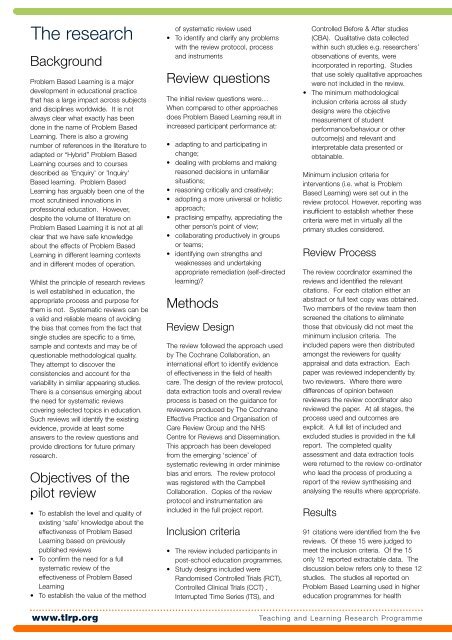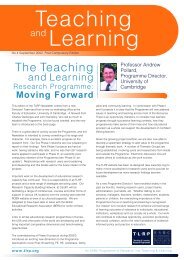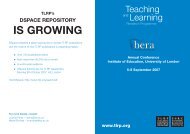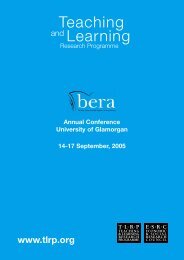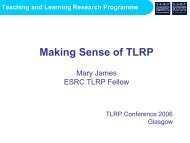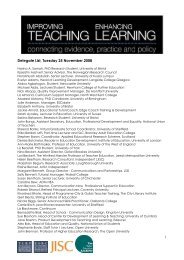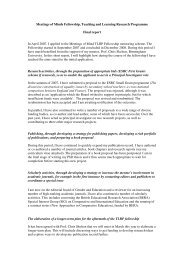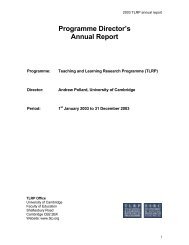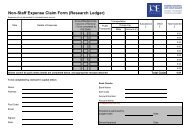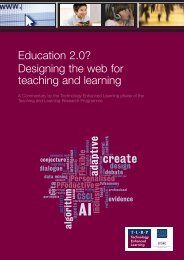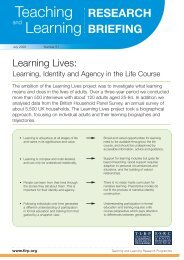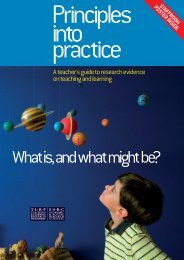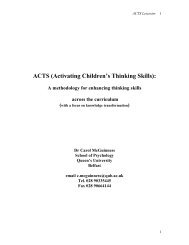The Effectiveness of Problem Based Learning 1 - Teaching and ...
The Effectiveness of Problem Based Learning 1 - Teaching and ...
The Effectiveness of Problem Based Learning 1 - Teaching and ...
Create successful ePaper yourself
Turn your PDF publications into a flip-book with our unique Google optimized e-Paper software.
<strong>The</strong> researchBackground<strong>Problem</strong> <strong>Based</strong> <strong>Learning</strong> is a majordevelopment in educational practicethat has a large impact across subjects<strong>and</strong> disciplines worldwide. It is notalways clear what exactly has beendone in the name <strong>of</strong> <strong>Problem</strong> <strong>Based</strong><strong>Learning</strong>. <strong>The</strong>re is also a growingnumber <strong>of</strong> references in the literature toadapted or “Hybrid” <strong>Problem</strong> <strong>Based</strong><strong>Learning</strong> courses <strong>and</strong> to coursesdescribed as 'Enquiry' or 'Inquiry'<strong>Based</strong> learning. <strong>Problem</strong> <strong>Based</strong><strong>Learning</strong> has arguably been one <strong>of</strong> themost scrutinised innovations inpr<strong>of</strong>essional education. However,despite the volume <strong>of</strong> literature on<strong>Problem</strong> <strong>Based</strong> <strong>Learning</strong> it is not at allclear that we have safe knowledgeabout the effects <strong>of</strong> <strong>Problem</strong> <strong>Based</strong><strong>Learning</strong> in different learning contexts<strong>and</strong> in different modes <strong>of</strong> operation.Whilst the principle <strong>of</strong> research reviewsis well established in education, theappropriate process <strong>and</strong> purpose forthem is not. Systematic reviews can bea valid <strong>and</strong> reliable means <strong>of</strong> avoidingthe bias that comes from the fact thatsingle studies are specific to a time,sample <strong>and</strong> contexts <strong>and</strong> may be <strong>of</strong>questionable methodological quality.<strong>The</strong>y attempt to discover theconsistencies <strong>and</strong> account for thevariability in similar appearing studies.<strong>The</strong>re is a consensus emerging aboutthe need for systematic reviewscovering selected topics in education.Such reviews will identify the existingevidence, provide at least someanswers to the review questions <strong>and</strong>provide directions for future primaryresearch.Objectives <strong>of</strong> thepilot review• To establish the level <strong>and</strong> quality <strong>of</strong>existing ‘safe’ knowledge about theeffectiveness <strong>of</strong> <strong>Problem</strong> <strong>Based</strong><strong>Learning</strong> based on previouslypublished reviews• To confirm the need for a fullsystematic review <strong>of</strong> theeffectiveness <strong>of</strong> <strong>Problem</strong> <strong>Based</strong><strong>Learning</strong>• To establish the value <strong>of</strong> the method<strong>of</strong> systematic review used• To identify <strong>and</strong> clarify any problemswith the review protocol, process<strong>and</strong> instrumentsReview questions<strong>The</strong> initial review questions were…When compared to other approachesdoes <strong>Problem</strong> <strong>Based</strong> <strong>Learning</strong> result inincreased participant performance at:• adapting to <strong>and</strong> participating inchange;• dealing with problems <strong>and</strong> makingreasoned decisions in unfamiliarsituations;• reasoning critically <strong>and</strong> creatively;• adopting a more universal or holisticapproach;• practising empathy, appreciating theother person’s point <strong>of</strong> view;• collaborating productively in groupsor teams;• identifying own strengths <strong>and</strong>weaknesses <strong>and</strong> undertakingappropriate remediation (self-directedlearning)?MethodsReview Design<strong>The</strong> review followed the approach usedby <strong>The</strong> Cochrane Collaboration, aninternational effort to identify evidence<strong>of</strong> effectiveness in the field <strong>of</strong> healthcare. <strong>The</strong> design <strong>of</strong> the review protocol,data extraction tools <strong>and</strong> overall reviewprocess is based on the guidance forreviewers produced by <strong>The</strong> CochraneEffective Practice <strong>and</strong> Organisation <strong>of</strong>Care Review Group <strong>and</strong> the NHSCentre for Reviews <strong>and</strong> Dissemination.This approach has been developedfrom the emerging ‘science’ <strong>of</strong>systematic reviewing in order minimisebias <strong>and</strong> errors. <strong>The</strong> review protocolwas registered with the CampbellCollaboration. Copies <strong>of</strong> the reviewprotocol <strong>and</strong> instrumentation areincluded in the full project report.Inclusion criteria• <strong>The</strong> review included participants inpost-school education programmes.• Study designs included wereR<strong>and</strong>omised Controlled Trials (RCT),Controlled Clinical Trials (CCT) ,Interrupted Time Series (ITS), <strong>and</strong>Controlled Before & After studies(CBA). Qualitative data collectedwithin such studies e.g. researchers’observations <strong>of</strong> events, wereincorporated in reporting. Studiesthat use solely qualitative approacheswere not included in the review.• <strong>The</strong> minimum methodologicalinclusion criteria across all studydesigns were the objectivemeasurement <strong>of</strong> studentperformance/behaviour or otheroutcome(s) <strong>and</strong> relevant <strong>and</strong>interpretable data presented orobtainable.Minimum inclusion criteria forinterventions (i.e. what is <strong>Problem</strong><strong>Based</strong> <strong>Learning</strong>) were set out in thereview protocol. However, reporting wasinsufficient to establish whether thesecriteria were met in virtually all theprimary studies considered.Review Process<strong>The</strong> review coordinator examined thereviews <strong>and</strong> identified the relevantcitations. For each citation either anabstract or full text copy was obtained.Two members <strong>of</strong> the review team thenscreened the citations to eliminatethose that obviously did not meet theminimum inclusion criteria. <strong>The</strong>included papers were then distributedamongst the reviewers for qualityappraisal <strong>and</strong> data extraction. Eachpaper was reviewed independently bytwo reviewers. Where there weredifferences <strong>of</strong> opinion betweenreviewers the review coordinator alsoreviewed the paper. At all stages, theprocess used <strong>and</strong> outcomes areexplicit. A full list <strong>of</strong> included <strong>and</strong>excluded studies is provided in the fullreport. <strong>The</strong> completed qualityassessment <strong>and</strong> data extraction toolswere returned to the review co-ordinatorwho lead the process <strong>of</strong> producing areport <strong>of</strong> the review synthesising <strong>and</strong>analysing the results where appropriate.Results91 citations were identified from the fivereviews. Of these 15 were judged tomeet the inclusion criteria. Of the 15only 12 reported extractable data. <strong>The</strong>discussion below refers only to these 12studies. <strong>The</strong> studies all reported on<strong>Problem</strong> <strong>Based</strong> <strong>Learning</strong> used in highereducation programmes for healthwww.tlrp.org<strong>Teaching</strong> <strong>and</strong> <strong>Learning</strong> Research Programme


